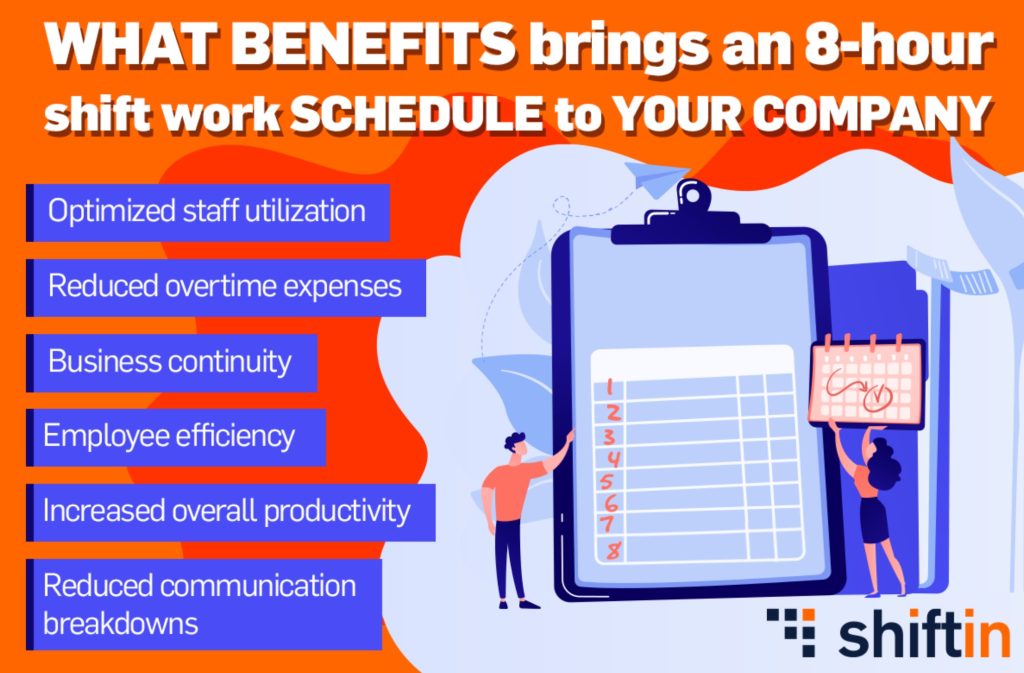- What is the 8-hour shift work schedule?
- The benefits of working 8-hour shifts
- How to plan a work schedule in 8-hour shifts
- Legal regulations on 8-hour shift work
- Using Shiftin to manage work schedules
The introduction of an 8-hour shift work schedule can significantly benefit your firm and its procedures. A rotating 8-hour schedule is very useful for organizations that are open around the clock, as is common in the retail, healthcare and manufacturing industries. In the following paragraphs, we will look at the 8-hour shift work program, the benefits it provides, how to arrange it efficiently, the legal regulations involved, and how our shiftin platform can help you manage your work schedules successfully.
What is the 8-hour shift work schedule?
An 8-hour shift work schedule allows employees to work a regular eight-hour schedule while ensuring that companies’ operations remain uninterrupted; for example, a 24-hour day can be broken into three portions, each with its own shift. This arrangement enables staff to work within an appropriate timeframe, boosting productivity and reducing exhaustion while also ensuring continuous coverage of critical processes.
The benefits of working 8-hour shifts
Implementing such a scheme brings multiple and significant benefits to both your company and employees. The 8-hour shift work model contributes to reducing expenses, improving employee efficiency, increasing the company’s productivity level, as well as reducing communication interruptions.
Economic viability
Employers often find that the 8-hour shift is financially sustainable since it optimizes staff utilization within a workday and reduces overtime expenses. Additionally, it fits in nicely with regular working hours, which makes coordination and communication easier overall.
Consistent staff coverage
Enforcing a shift pattern consisting of eight hours guarantees steady worker coverage throughout the day. This is especially crucial for businesses that must operate around the clock and require ongoing attention to ensure business continuity. Efficient shift management can provide adequate staffing for shifts, lowering the possibility of disruptions resulting from unanticipated events related to personnel shortages.
Increased employee efficiency
One of the most significant benefits of an 8-hour shift work schedule is the improvement in employee efficiency. Staff can maintain a steady and predictable work pace, as they are provided with a clearly defined work schedule. Minimal burnout leads to enhanced productivity and more consistent work performances.
Reduced communication breakdowns
Through reducing the frequency of shift changes, an 8-hour work schedule can help limit the likelihood of miscommunication within a company. Employees can conduct more comprehensive and well-organized handovers, ensuring that important updates and assignments are delivered clearly, with fewer shift transitions. This consistency improves team alignment and lowers error rates, especially in settings where prompt and precise communication is crucial.

How to plan a work schedule in 8-hour shifts
Planning an 8-hour shift work schedule requires a thorough analysis in regards to your business’ requirements, the preferences of existing employees as well as the attractiveness of the business for new hires and legal obligations based on the country and industry in which the firm operates.
As with any modern business, digital transformation is able to provide substantial benefits to the modus operandi of your firm. Picking the correct software solution marks a critical step forward for successful shift management.
Legal regulations on 8-hour shift work
Legal regulations play a crucial role in the implementation of an 8-hour shift work schedule, and compliance is essential in the European Union and elsewhere. One of the key aspects to consider is working hours. European Union legislation states that the total weekly hours worked should not exceed the legal limit of 48 hours a week, including overtime. Any overtime should be compensated in accordance with local labor laws. Additionally, employees are generally entitled to a minimum amount of rest each week, in the EU this is a minimum 24 hour rest in every 7 days or a minimum of a 48 hour rest in every fortnight.
Depending greatly on the business you operate in, health and safety rules may also mandate extra breaks for workers who work night shifts or undertake physically demanding duties. It s therefore critical to keep up with local regulatory standards, considering noncompliance can lead to fines and reputational damages.
Using Shiftin to manage work schedules
shiftin is a comprehensive shift scheduling software solution, designed to simplify the management of shift work schedules. One of its primary benefits is automated scheduling, that serves as a tested and trusted HR management tool, helping HR departments create, edit and distribute shift schedules smoothly. Our shiftin platform enhances the communication between managers and employees, as it allows for real time shift schedule adjustments and accomodates each and every employers schedule/preferences. It is a highly transparent platform; employees can view schedules, request time off and swap shifts, leading to a reduced reliance on HR departments.
9/10 employees reported satisfaction with their schedule, and you could be the next to join the organizations that already trust our solution, shiftin to manage shift scheduling.





